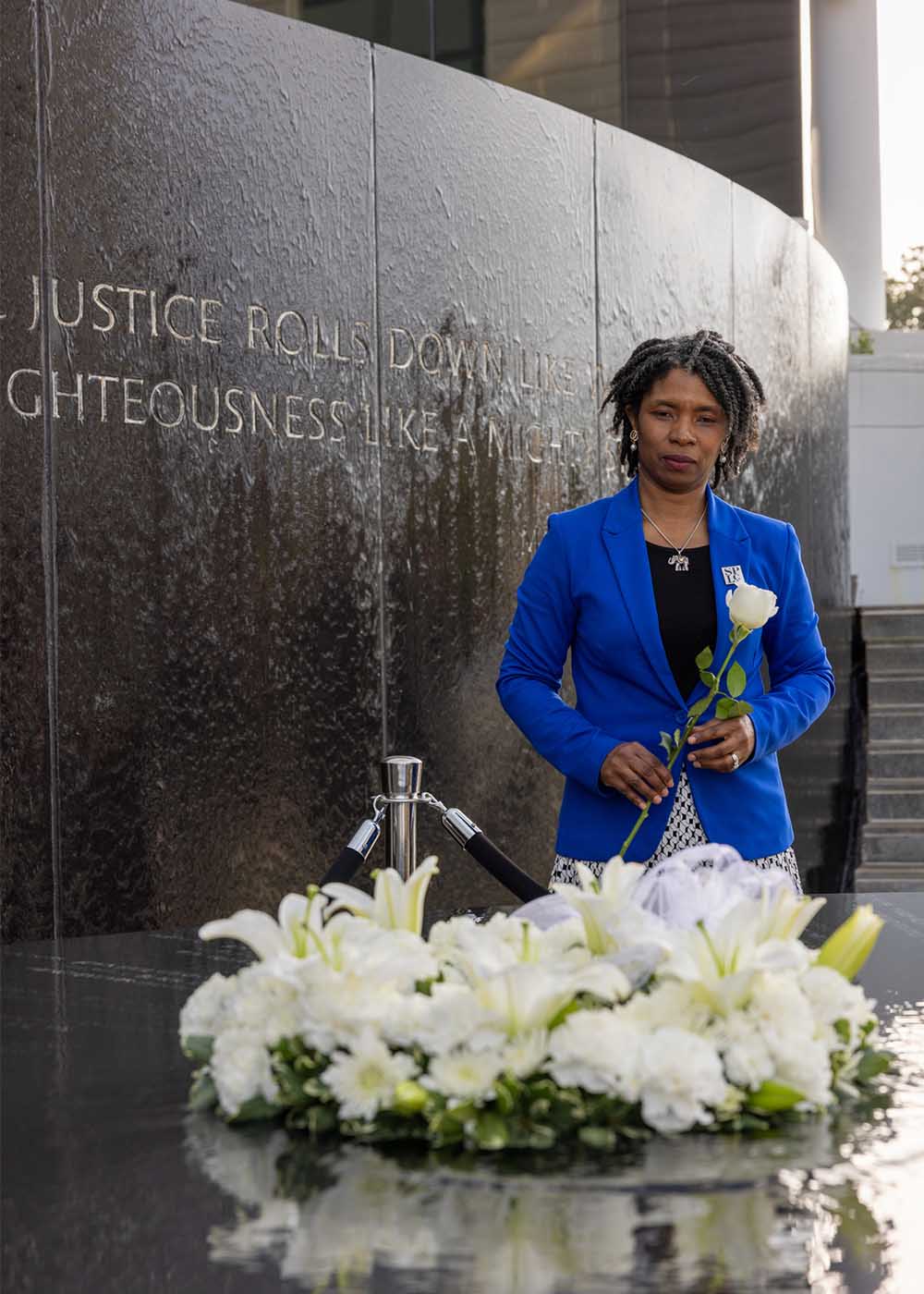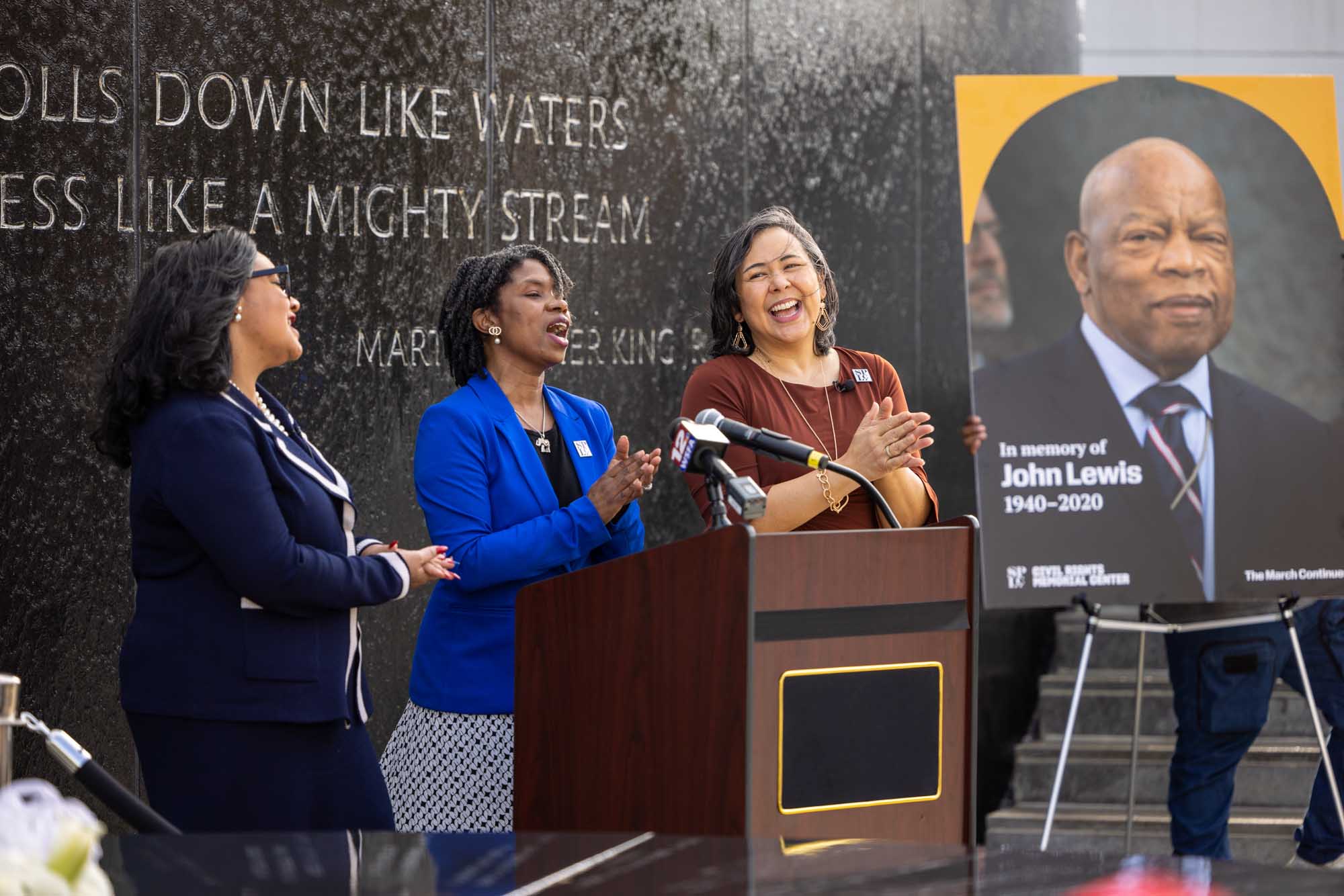Congresswoman, activists honor John Lewis by laying wreath at Civil Rights Memorial
As the nation turns its eyes toward Alabama to mark the 58th anniversary of the Bloody Sunday voting rights march across the Edmund Pettus Bridge in Selma, a group gathered today at the Civil Rights Memorial in Montgomery to honor the late U.S. Rep. John R. Lewis and 40 martyrs who died during the height of the civil rights movement.
“He [Lewis] knew the way forward was having an understanding of where we have been,” Southern Poverty Law Center President and CEO Margaret Huang told the more than 100 people gathered around the Memorial. “What we must remember is that the stories of the civil rights movement are the American story.”
In video: A wreath-laying ceremony is held March 3, 2023, at the Civil Rights Memorial in Montgomery, Alabama, to honor the late U.S. Rep. John R. Lewis.
U.S. Rep. Nikema Williams, who succeeded Lewis in Georgia’s 5th Congressional District, noted the need for remembrance.
“Today’s wreath laying reminds us that the violence that these martyrs suffered has not gone away,” Williams said. “We lift up their courage and convictions so their stories are not forgotten.”
She also cited the necessity of continuing the fight for voters’ rights.
“It’s a shame that in the year 2023 I am still fighting for the same rights John Lewis lost blood for that day,” Williams said.
Tafeni English-Relf, director of the Civil Rights Memorial Center (CRMC) and recently announced director of the SPLC Alabama state office, joined Huang and Williams in laying a wreath of white roses on the Memorial’s round, granite table, where a thin sheet of water flows over inscriptions that commemorate significant events of the movement and records the names of martyrs who were slain during the struggle for equality.
The Memorial, sponsored by the SPLC and designed by Maya Lin, was dedicated in 1989. It is located across the street from the SPLC’s headquarters building, in an open plaza accessible to visitors 24 hours a day. The SPLC opened the CRMC in 2005 to serve as the Memorial’s interpretive center. After closing temporarily during the pandemic, the CRMC reopened last year with a redesign that includes new exhibits and updates.
For many years, Lewis led a delegation of congressional and civil rights leaders to the Memorial for this event. Joseph J. Levin Jr., SPLC co-founder and board emeritus, said he once told Lewis that the SPLC, and the monument, would not exist if it weren’t for Lewis’ work in the civil rights movement.
“We cannot forget those heroes who died and suffered for this civil rights movement,” Levin said.
On March 7, 1965, Lewis – then a 25-year-old leader in the civil rights movement – was severely beaten and nearly died when local and state police attacked 600 peaceful marchers who attempted to cross Selma’s Edmund Pettus Bridge as they embarked on a 54-mile march to the state Capitol in Montgomery in support of voting rights.
After the televised assault shocked the nation, thousands of activists, including Martin Luther King Jr., poured into Selma. After a second, symbolic attempt, on March 21, the marchers – now protected by the National Guard under federal control – embarked for a third attempt, and three days later some 25,000 arrived in Montgomery. The next day, they walked to the Capitol steps, where King delivered his iconic “How Long, Not Long” speech. Five months later, President Lyndon B. Johnson signed the Voting Rights Act of 1965 into law.
As today’s ceremony drew to a close, the crowd sang several verses of “This Little Light of Mine” as some attendees laid single long-stemmed white roses on the Memorial.
The martyrs whose names are listed on the Memorial were murdered because they were active in the movement; were killed as acts of terrorism aimed at intimidating civil rights activists; or were those whose deaths, like that of Emmett Till, helped spur the movement forward by demonstrating the brutality faced by Black people in the South.
Picture at top: From left: Tafeni English-Relf, director of the Civil Rights Memorial Center; U.S. Rep. Nikema Williams of Georgia's 5th Congressional District; and Margaret Huang, SPLC president and CEO, lead the wreath-laying ceremony at the Civil Rights Memorial. (Credit: Lynsey Weatherspoon)


